A Simple Explanation of Application and Neurophysiological Basis
By Doctor Chris Palmer
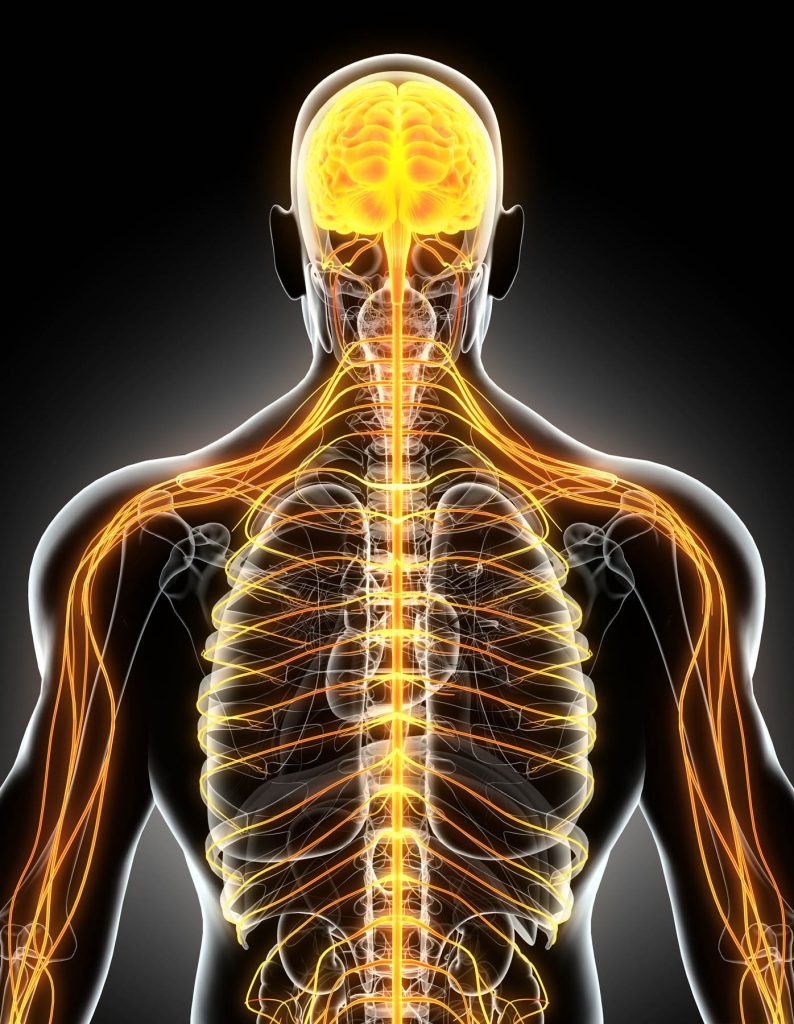
What is Muscle Testing? Muscle testing, or muscle response testing (MRT), can be powerfully effective as a diagnostic tool in so many situations. Because of the usefulness and broad scale applicability of this tool it is considered by many to be one of the most basic and essential items to have in a practitioner’s tool kit. Over the years I’ve heard people say all kinds of things about it (some good and some bad), but often there are questions about how it actually works.
Some things I’ve heard about muscle testing, or the practitioners that use it, have been about how wonderful, affective and useful it is. Other things I’ve heard indicate that it’s more along the lines of witchcraft, voodoo, and meddling with dark powers best left alone. Even people who are really quite open to it sometimes joke about the “voodoo” that some practitioners do when they use it.
I’ve seen muscle testing used for testing anything from supplements for a person, to getting answers from a person’s subconscious, to testing functional aspects of a physical body, and all kinds of things! I even saw a short video clip one time of a person using muscle testing to figure out what was wrong with a broken car! It was quite funny, but obviously intended to be a joke.
Some of what I’ve seen with muscle testing is truly amazing in what it offers diagnostically, and other things I’ve seen are nothing more than pure silliness and nonsense. So in talking about muscle testing, let’s start at the beginning and see if we can set a few things straight. Although I will not take time to get too bogged down in the details, I feel that a little bit of technical understanding in places is important to have.
Muscle testing is a diagnostic tool that has been around in a legitimately recognized medical capacity since the early 1900’s. It was developed by a medical doctor, Dr. Robert W. Lovett, M.D., in 1915. Dr. Lovett was documenting the progression of muscle weakness in polio patients, and he used muscle testing in his work in that capacity. Since then, others have contributed to the subject and application of muscle testing in various ways over the years, including Florence Kendall, Dr. Frank Chapman, D.O., Dr. George Goodheart, D.C., Dr. George Gonzalez, D.C., and many others. Today muscle testing is used by doctors of various disciplines, health and wellness practitioners of various kinds, and even regular every-day people in general.
In its basic sense, muscle testing is purely physiological in nature—it’s simply a functional test of muscle innervation and nothing more, which is why Dr. Lovett was using it in his work with polio victims. So for those who are squeamish on the subject, any strangeness that people may see with muscle testing comes from how this basic physiological function is applied—not from the muscle test itself. For those who would like more technical details on the subject, studies and peer reviewed research on the validity and efficacy of muscle response testing can be found in reasonable abundance online. So, as many of you may appreciate, I won’t take the time to go over them here.
However, in spite of overly critical or uneducated ideas to the contrary, the neurophysiological basis of muscle response testing is the only principle upon which it works. In other words, to put it simply, it all comes down to your anatomy and physiology, period, end of story. Disappointing as it may be to some, there’s no “voodoo” involved, only mere neurophysiology, which is easily shown.
To state this a little differently, the human body is a physical thing, so muscle tests of the physical body are, and can only be, based on the principles that dictate how the physical body works. When there are questions about the validity of muscle testing, the real questions aren’t about whether or not it works, but instead, whether or not the nervous system is, or can be, effectively stimulated in order to get a response.
In application of muscle testing, the power of its diagnostic ability comes when we are able to use a fully innervated and functional muscle, and find ways to consistently either maintain its strength, or weaken it. For most applications, comparatively large or otherwise convenient muscles are used. Large or convenient choices may include the deltoid muscle of the shoulder, the pectoralis major muscle of the chest, the bicep muscle of the arm, or psoaz muscle of the torso. But technically speaking, any muscle in the body will work when tested appropriately, and there are various ways and techniques that muscle response testing can be applied.
To perform a muscle test, simply isolate a muscle, or muscle group, and stress it. If it stays strong under a reasonable amount of pressure over a reasonable amount of time, that’s a positive test.If it goes weak, that’s a negative test. A good amount of test time and pressure to use might be around 2 to 4 pounds of pressure over about 1 to 3 seconds. Obviously the age and general strength ability of a person needs to be taken into account.
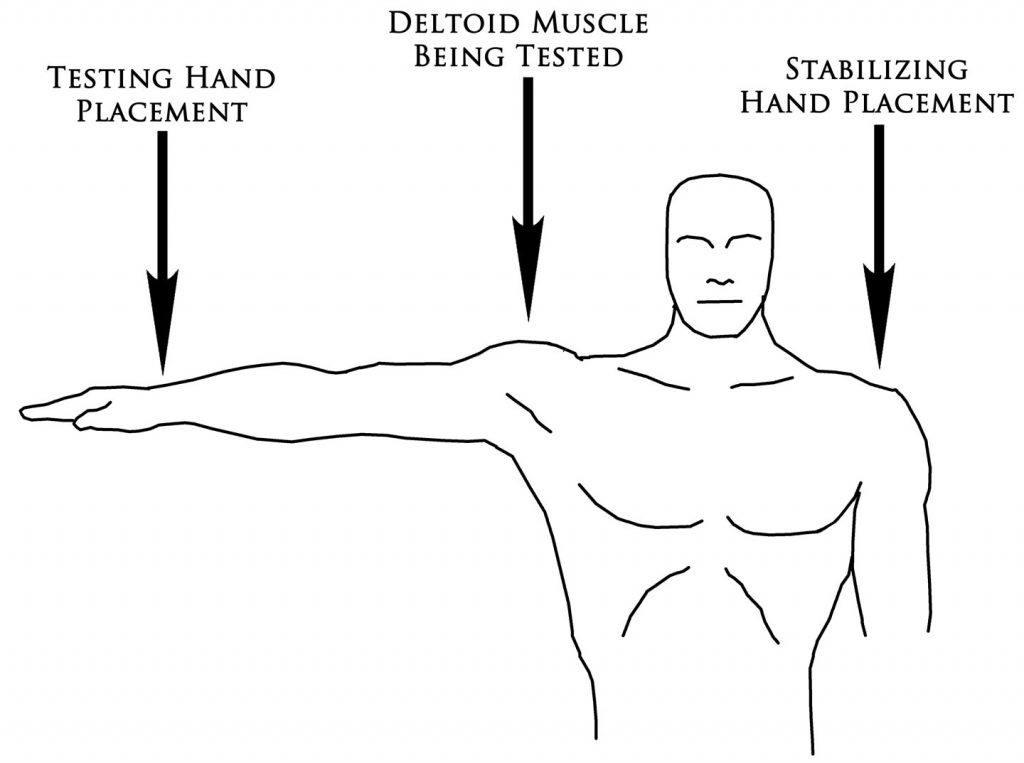
As just one of very many examples, a person being tested could hold their arm out at a 90° angle from the side of their body. This would be testing the deltoid muscle of the shoulder of that arm. The person performing the test would then face the person being tested. Then, the person performing the test, using the hand that was on the same side as the arm being held out at 90 degrees of the person being tested, would put two or three fingers of that hand an inch or two above the wrist of the arm of the person being tested. The person performing the test would also put their other hand on the top of the opposite shoulder of the person being tested, in order to stabilize them during the test. See the following illustrations.
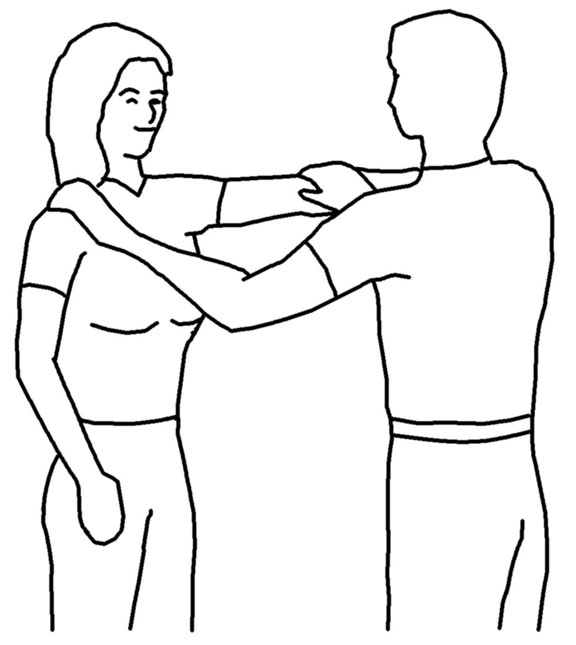
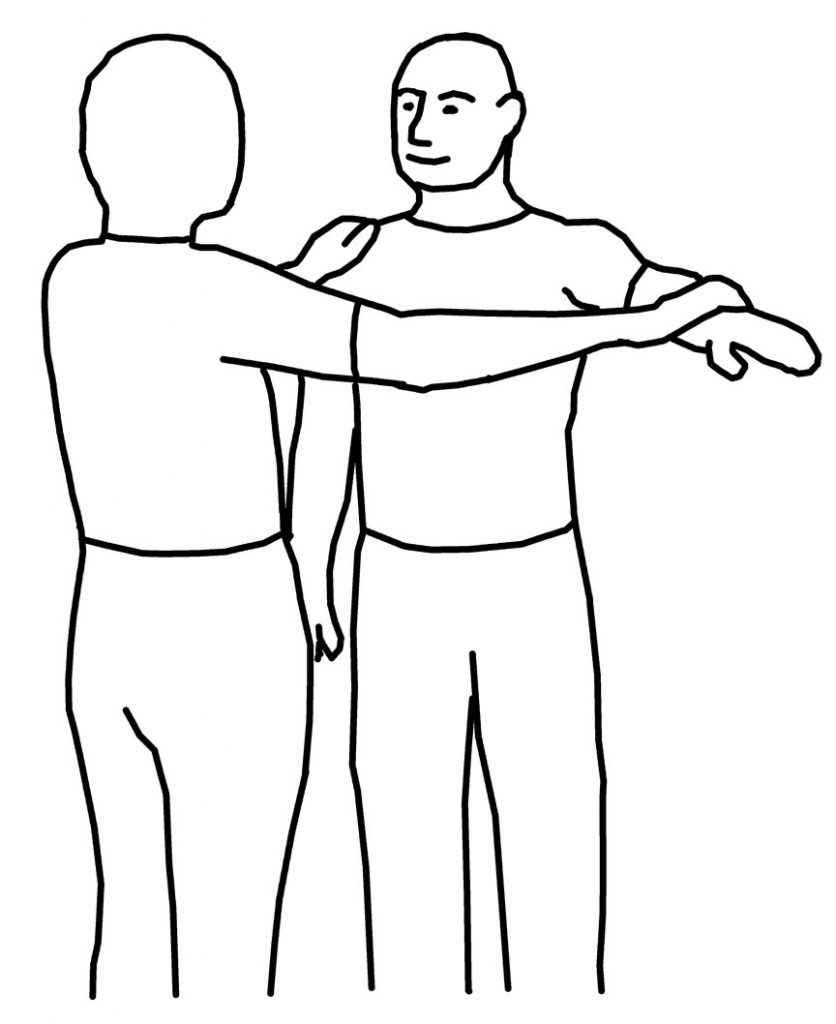
After lightly touching the person’s arm so that the deltoid muscle is engaged, the person performing the test would then use a reasonable amount of force (2-4 lbs. of pressure) and press down on the arm just above the wrist of the person being tested. The person being tested would resist that force and attempt to keep their arm straight. If the arm of the person being tested stayed strong, with good muscle strength and “lock” to the muscle, this would be a positive test. If the arm of the person being tested went weak and dropped closer to their side as a result of the pressure, this would be a negative test.
In a general sense, the area being contacted by the person performing the test would be close to the end of the lever of the muscle being tested. In literal application this would be the distal part of the arm in the case of the deltoid or pec. Major muscles, or just above the knee in the case of the psoaz muscle. It should also be pointed out that the purpose of the test is not to overpower the muscle—that’s not hard to do. Instead, the purpose of the test is simply to apply enough force to see if it is fully innervated by the nervous system, i.e. if it stays strong, or not.
Also, lightly contacting the arm just above the wrist before applying more pressure gives the muscle being tested an opportunity to engage and be ready before the test is performed. Having the muscle lightly engaged before the muscle response test increases the likelihood of a valid and effective test. Otherwise, if the muscle is not already lightly engaged before the test, it can be easily overpowered or “surprised” and may give a false negative.
Without going into technical reasons as to why one muscle would be picked over another to use, or why one type of muscle test might be used instead of another, let me simply say that there are various common ways that muscle testing is performed. To be simple, just pick a convenient large muscle that doesn’t have any problems and that should work fine. If it doesn’t, find out what the problem is and fix it, or pick a different muscle, then try it again—repeat as necessary.
Isolating a specific muscle, as in the example before, is common, and is often used by practitioners assessing a client or patient. However, another muscle test that is common, is to make a ring with the thumb and index finger of one hand, and then lightly pull a finger from the other hand through where the thumb and index finger meet. If the finger easily passes through the ring, this is a negative test. If the finger cannot easily pass through the ring and is stopped, this is a positive test. See the following illustration.
This particular muscle test is much less conspicuous than many other muscle tests, which is good for use in crowds of potentially squeamish people. It’s also easy to perform on one’s self as well. There are also other slight variations of this test that can work well too.
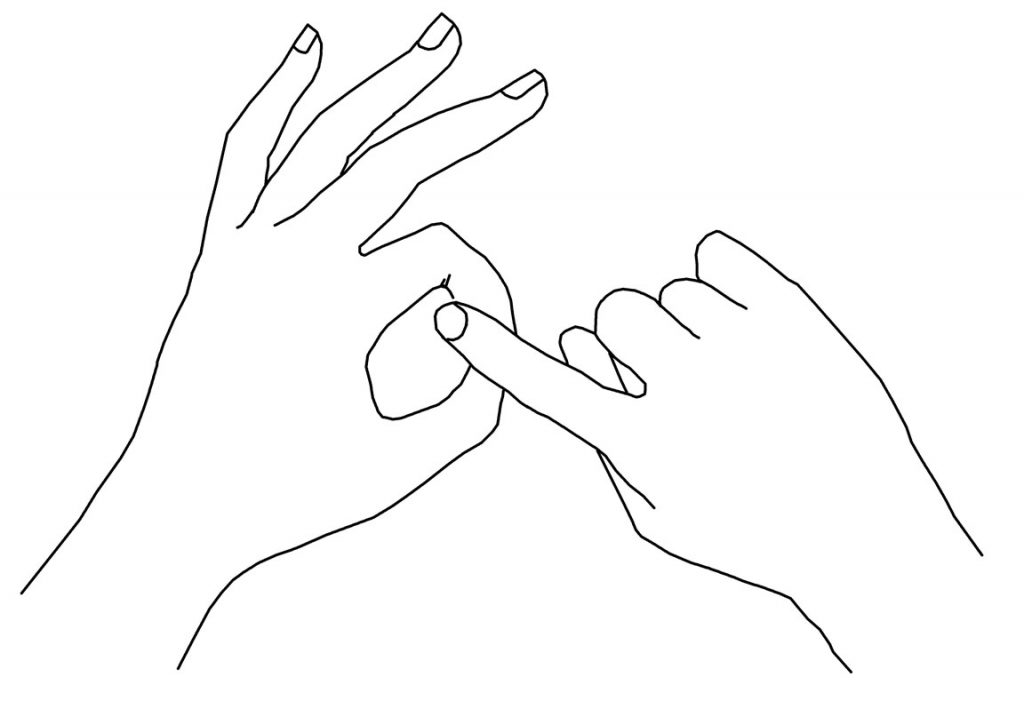
Another common muscle test is called the “sway” test. This test is also easily done by a person for themself, and simply tests to see if a person sways slightly forward or backward in response to the subject being tested. For this test, swaying foreword is a positive response and swaying backward is a negative response. The rationale in this is that things that are good for the body (the nervous system) will draw it, hence the forward sway. And things that are not good for the body will repulse it, hence the backward sway. See the following illustration.
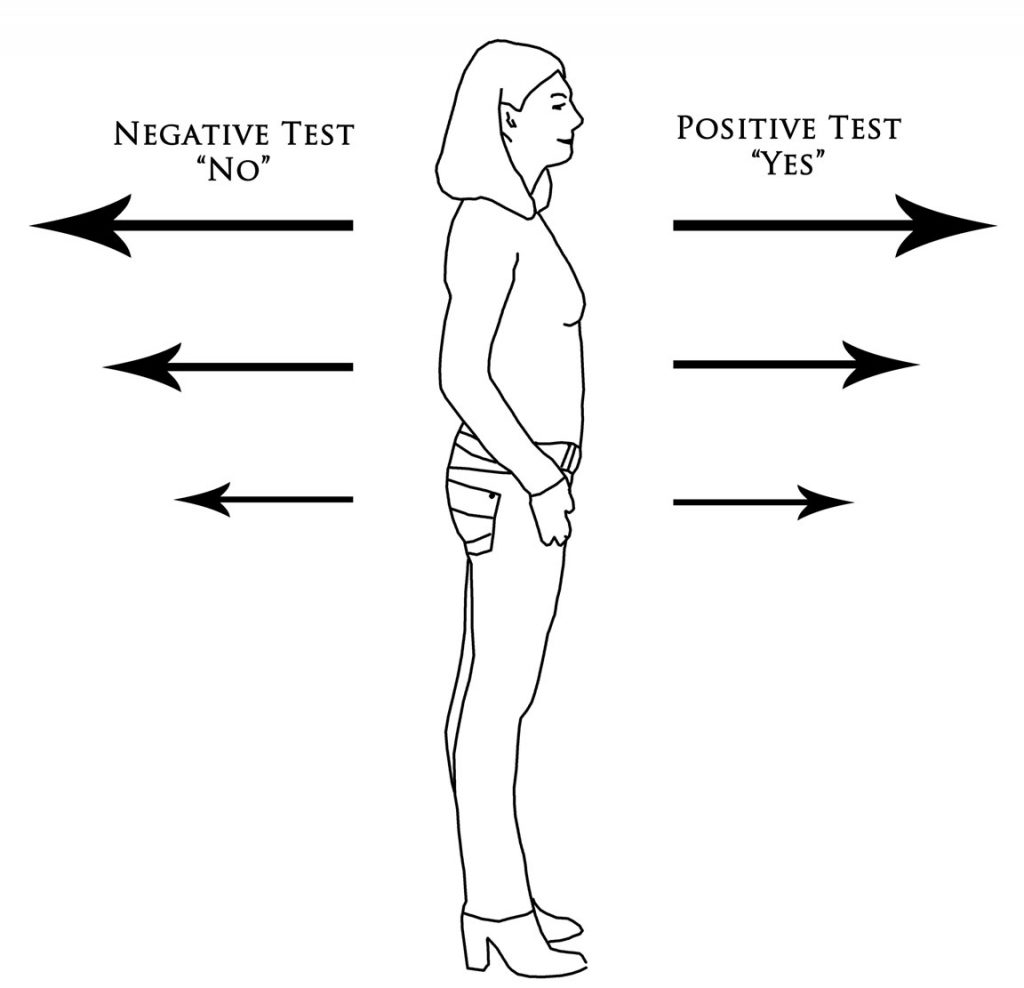
As a quick note on performing muscle tests, everything new has a bit of a learning curve. No one is perfect on their first try, and muscle testing is no exception. As with everything, practice will improve this skill and a person’s ability to work with the body. Practice also helps to train the body as to what is being requested of it for a positive or negative test response.
Beyond these common tests there are numerous ways to test a muscle or muscle group. Also within the realm of muscle testing, there are different levels of application, for lack of a better way to put it, that we can talk about. Because muscle response testing is nothing more than taking advantage of neurophysiological reactions in the body, all levels of application are based on the nervous system’s ability to react to stimulus, and therefore maintain or change the strength of a fully innervated muscle.
That there are different levels of application for muscle response testing,is clear. But what constitutes one level or another may be different depending on who is doing the defining. So I will here lay down some different levels of application to illustrate the differences between them, knowing that there may be a bit of leeway in some of these applications as to one level or another, depending on who’s opinion or critique is being invoked. The point of this is not so much to try to rigidly define the levels of application for muscle response testing, but simply to show the relationship that they have to the neurophysiological responses of the body. Also again, the question isn’t whether not muscle response testing is effective. The only real question is “to what degree” it is effective.
Level 1
On the basic level, level one we could say, we have simply testing a muscle for strength, like what Dr. Lovett was doing with polio patients. With this we can see the level of innervation that any specific muscle has. These specific muscle innervations are referred to as myotomes, and correspond to specific spinal nerves as they exit the spinal cord and spine. Different levels or amounts of muscle innervation—and therefore muscle strength—can be tested and graded on a 6 point scale. On this scale 5 is a fully innervated and strong muscle, and 0 is a muscle that is totally flaccid with no sign of function or innervation at all.
This basic kind of muscle testing is standard as part of any neuromuscular evaluation in a doctor’s office. But beyond standard medical evaluation, today there are also various diagnostic and treatment techniques that utilize this kind of muscle testing in health and wellness care very effectively. Whereas basic muscle strength rating goes on a scale from 0/5 to 5/5, beyond this basic level one muscle testing, everything in level two and up effectively only uses muscles that are fully innervated and strong, or 5/5 on the scale. At level two and up, if a muscle is deemed to be not fully functioning, a different muscle is sought for testing.
Level 2
At level two we could add to the basic muscle test, testing substances or processes that have a direct physiological effect on the nervous system. In this case, any substance or process that the nervous system perceives as beneficial strengthens it, and therefore a muscle test also. Contrarily, any substance or process that the nervous system perceives as detrimental weakens it, and therefore a muscle test also.
As one example for this second level of testing we could talk about supplement testing. In this case, a nutritive supplement being tested would, in most cases, have to be able to be tasted in the mouth for there to be good direct recognition by the nervous system, because taste is how the body neurologically recognizes food substances. Other examples might include placing a magnet on the body to find out if its placement is beneficial or detrimental to the body. Electromagnetic waves of a cell phone or other electronics could be tested in this manner as well. In short, anything that could be effectively ascertained by the nervous system through any of the five senses or other effective physiological means could be tested with a muscle strength test. This would be because of the direct effect that the substance or process had on the nervous system—which is what powers muscles.
Also at this level, or maybe we could say level 2.5, we would also have evaluations of a mental type. With this we could communicate with the subconscious mind through asking questions of either an auditory, visual, or tactile nature. By this I mean, for example, that we could verbally ask a person a question or have them read it off of a paper. Or if they were blind we could have them read Braille if they knew it.
Each of these methods of communication have direct physical entry into the nervous system through whichever of the five senses are applicable. This communication will register with the subconscious (and conscious) mind, and therefore also have an effect on the nervous system—and consequently a muscle test. In this, some questions are more effective than others to use, and will hence result in a better and more noticeable neurological response, i.e. muscle test. But in any inquiry, questions that can be answered with a simple “yes” or “no” about a single piece of information are effectively required.
To add just a little more detail here, for questions that are asked when seeking a neurophysiologic response like a muscle test, the dynamic of how a strong or weak muscle response is obtained will be completely dependent on how the question is asked. To be simple, from the perspective that things that are good for the body will strengthen it, and those that are detrimental will weaken it, it is reasonable to assume, and generally is, that “yes” answers will come with a strong muscle response and “no” answers will come with a weak one. It is also found that truth will have a positive effect on the subconscious mind and elicit a strong muscle response, and falsehood will do the opposite.
Additionally, a question that is phrased in the positive sense will have the opposite answer of the same question that is phrased in the negative sense. For example, “is this supplement good for me” will have the opposite response of, “is this supplement not good for me.” These two questions are asking about the same thing, but the first question is phrased in the positive sense, and the second one in the negative sense. As another more complex example, “is this supplement not good for me,” would get the opposite muscle response of, “is this supplement not, not good for me.” Again, these two questions are asking about the same thing. But in the last question, notice how the double negative negates the first not and changes the phrasing of the question, and hence will change the strength or weakness of a correct response in a muscle test.
My point here is not to be complex—it’s simply to point out that how we ask a question will have an effect in the response from the subconscious mind through the nervous system, and hence what we receive in the muscle test. In this, the important thing to remember is that whatever the body perceives as good in any sense will strengthen it, and produce a strong muscle response. But whether this means “yes” or “no” for any particular question depends completely on the specific context and way in which it is asked.
Additionally, to make a quick point of interest, asking an opposite second (or follow-up) question on a subject can be a good validating check for the first question’s test response. In this case one would simply restate the question that was just asked in such a way as to correctly require the opposite answer of the first, and then test again. If the second question gets the opposite answer of the first, this is a good validation. If not, then we need to recheck something.
An example of this might be asking if a supplement was good for the body and getting a strong muscle response, and then asking if the supplement was not good for the body and getting a weak muscle response. If the muscle responses are consistent like this, this validates both tests. If they are not consistent, like if both responses are strong for example, this indicates that there is a problem and one of the tests is not correct , or one question not specific enough. So asking an opposite follow-up question can be a good check of accuracy.
Level 3
From here, for a level three muscle test we could say that the body would not have to be directly physically stimulated to get a nervous system response, but that simply having something in the body’s energy field would adequately suffice as a stimulus and get the same results. The idea from this perspective is that the body is sensitive in more ways than merely the five basic physical senses, or other direct physiological stimulus. In this case, something to be tested could simply be placed in a hand, or within a close proximity to the body to be tested.
For example, a bottle of a particular supplement, or simply one of the pills from the bottle, could be placed in a person’s hand and then muscle tested for efficacy, instead of in the mouth. Or if there were multiple supplements to be tested, a combination of the bottles, or a pill from each one, could be placed in a person’s hand and then muscle tested. In this case, although the neurological stimulation would not come through cranial nerves IX, X, and XII, which innervate the tongue and sense of taste, it would be gained through the body’s energy field, which also affects the nervous system. Oftentimes holistic health practitioners also test allergies in this way, and there are many other applications as well.
Level 4
The next level of muscle testing, level four, would include using representative items to elicit a nervous system response, and therefore a testable muscle response. This concept of muscle testing is based on the idea that the body has memory of things that it has already encountered, and can therefore react according to that memory when it is consciously or subconsciously triggered. A good example of this would be muscle testing using a vial of liquid that representatively identified some particular substance that a person had already been in contact with at some point.
The substance itself would not be in the vial, the contents the vial contained would simply be labeled or otherwise identified as the substance. Additional examples could simply be a picture, or anything else that would represent a formerly interacted-with substance. As long as the body had interacted with the substance in some way in the past, and was able to neurologically remember it, this would work as well as any other way.
Level 5
At the next level, at level five let’s say, we could simply verbally, or in any other way, reference a substance being tested without having a representative physical object present. In this case we might simply have a piece of paper with the name of any particular substance, or simply say what we are referring to. Level five would be similar to level four, in that it would be based on the idea that the body has memory of things that it has already encountered. As before, triggering the memory of the item would elicit a nervous system response that would include a strong or weak muscle test. The difference between level 5 and previous levels would simply be that the substance in question was referenced, instead of actually being present or otherwise physically represented. In level four and five there is still direct neurological stimulation through one of the five senses—for example, auditory or visual if it is a verbal or graphic reference—or otherwise simply through the body’s energy field as may be applicable.
Level 6
To this point, all of our applications of muscle testing have been with things that directly interact with the body, either mentally or physically, in order to elicit a change in the nervous system. But at level six we start including things that would require a greater perception on the part of the body in order to still elicit a measureable nervous system response and muscle test. Level six would be based on the idea that perception is not limited merely to the physical body. It would also include various ideas like, the perceptive abilities of the subtle energetics of the body, the idea of a Higher Self in whatever definition, and other things. Really, there are a lot of different ideas that could be included at this level, all of them indicating that a human being is more than the mere mortal physical body.
Specific applications of muscle response testing at this level would include things like muscle testing in proxy. This would be something like testing yourself for someone else, or muscle testing another person for someone else. An example of this might be testing yourself for your child, or testing a parent for one of their children, etc. It would also include muscle testing for a person who was some distance away—like for someone who was somewhere else in the city, or even somewhere else in the world.
This level would also include the possibility of testing for things with which a person has not had personal experience with, but may otherwise know something about. Although, on this last point, my personal experience is that muscle response testing is far more reliable when the person being tested, or at least the person doing the testing, has had personal experience with what is being tested for. This is also where, quite frankly, things can get a little “off,” and people can start getting results where the reliability comes into question—and people are more likely to make comments about things like “voodoo” and such. So naturally, more than any other, this area is where a person will need to be most careful about what they’re testing for and what they’re getting. But again, the whole question is about whether or not the nervous system can be sufficiently stimulated, and then tested in one way or another.
At level six, muscle testing is still based directly on neurophysiological response—that’s the only way muscle testing works—period. The only difference is that this level of application accepts the idea that a person’s physiology can be affected by things that are often referred to as metaphysical, or at least moving in that direction. But again, muscle response testing is, in all cases, based on the nervous system’s ability to respond to whatever stimulus it is presented with. Because muscles are controlled and powered by the nervous system, if there is no change in the nervous system then there can be no change in the muscles—end of story. From here, the only real questions that exist pertain to what can affect the nervous system, and what cannot. In reference to this, often the conflict at this level comes with what a medical mindset excludes, and what a holistic mindset includes. Beyond this, muscle testing is all the same.
*****
As an additional point about muscle response testing, it is important to understand that there are some things that can inherently and consistently cause problems. For example, muscles that are neurologically compromised by injury, disease, or anything else, will not yield consistent, reliable results. Also, if there are multiple influencing factors on a muscle test, this will make it difficult or impossible to get a reliable or correct response. Many times this can be from simply asking questions that are not specific enough, or that reference more than one item that can be tested.
For example, “Is this supplement good for me or bad?” is an ineffective question to ask. This question is actually two rather non-specific questions, which will likely have two different answers. This question should be broken down into multiple questions and rephrased. With a question like this you wouldn’t know which query was actually being answered.
It would be much more effective to ask this question as a set of questions, phrased something like the following. For example, “Is this supplement good for my body?” (For this example assume a STRONG/YES muscle response). Then a good follow up question would be, “Is this supplement not good for my body?” For this question the proper response would be a WEAK/NO muscle responseif it confirmed the answer to the first question. A next question could be, “What percentage will this supplement benefit my body?” and then muscle test for the percentage (10%, 20% … 80%, 81%, 82%…, etc.). Then find dosage with questions like: “How many (i.e. capsules) should I take at a time?” Then test for quantity: (1, 2, 3, 4…, etc.). Then, “How many times a day should I take this quantity?” Then test for frequency (1, 2, 3, 4…, etc.).
As you can see, any one question on a subject may actually require several different specific smaller questions in order to get a good, reliable idea of the correct scenario. But even with good, specific questions, common sense must always be used. For example, just because a very depleted body might test positive for needing ½ bottle of synthetic vitamin C (ascorbic acid) at a time, 3 times a day, doesn’t mean that this is actually healthy or wise! Many synthetic vitamins, like ascorbic acid, are toxic after a certain point. So even with good questions, sometimes more detective work and more supporting knowledge of the subject are needed for some situations.
Also, a person should be careful trying to test for things that are simply out of their knowledge base—like as can sometimes be the case with level 6 testing above. As noted, this can potentially lead to problems with true accuracy of muscle tests. Be careful in these areas. Additionally, a strong conscious or subconscious intent to get a specific answer can also potentially influence or bias results that are obtained. For example, if the person testing, or the person being tested, really wants a particular answer, or if either is very afraid of getting some specific answer, this can potentially affect the accuracy of a muscle test. Because of this a person should be as neutral as possible on the potential outcome of the test.
Furthermore, and this is important, from a subtle energetic perspective, things that can potentially affect the subtle energies of the body will also affect its physiology, and can therefore also affect a muscle test. Because of this, I highly recommend that a person performing a muscle test, and the person being tested, both clear their energies and shield themselves as talked about in my book, Basic BioEnergetics, before doing the testing. Otherwise muscle tests may not be as effective as a person thinks or as effective as is needed—and they may not even know that there’s a problem. This is an important point that many people don’t recognize, so please take it seriously!
I have seen people get answers that are simply not correct (like not even being able to test strong for their own name, for example) when they are not energetically cleared and shielded. I have likewise seen people have a difficult time getting consistent and reliable answers when they weren’t energetically clear and stable. I have also seen those problematic results change to being consistent, reliable and knowingly correct when a person has then taken the time to energetically clear and shield themself.It isn’t always an issue, and it may sometimes be less of an issue for purely physiological muscle tests (like myotomes for example), but no one is so good that they can’t be influenced by aberrant or unstable subtle energies. Again, this is an important point; please take it seriously. Muscle testing results will be better and more consistent for it!
Finally, as a last point on the topic, when a person is trying to narrow down possibilities, like with numbers or items from a list, there are more effective and less effective ways to do this. With numbers of a percentage for example, a person could begin at 1 and simply start counting to 100, testing every single number along the way to see if it was the correct one. But this would obviously be rather tedious and take a relatively large amount of time to accomplish. A better way would be to simply hold pressure on the engaged muscle, and then count by tens until the muscle went weak. Then, when the muscle went weak, this would give an indication of the unit of 10 where the tester had passed the correct number or percent. The muscle tester could then start again at the last unit of 10 that the muscle stayed strong on, and then count forward by ones until the muscle went weak again.
For example, if the muscle tester was counting by tens towards 100 to find a percentage, and the muscle being tested went weak at 80, this would indicate that the correct percentage was somewhere between 70 and 80. The person performing the test could then begin again at 70 (where the muscle would still test strong) and count forward by ones until the muscle went weak again—let’s say on 77. The last number that the muscle stayed strong on (76) would be the correct number or percentage. Then a follow up question could be muscle tested to confirm that percentage.
A similar method of narrowing down from large to small units can be used to find a number in a very large pool of possibilities as well. If, for example, a person was looking for a value between 1 and 10,000, a person could use the same process as above to narrow the possibilities down by thousands, then by hundreds, then by tens, and finally by one’s, to find the specific number sought. Similarly, when seeking a correct item out of a list of possibilities, a person can divide the list into categories and narrow it down from there.
For example, items that are listed in columns or rows, the columns and rows could be and tested first to find the correct column and/or row, and then specific items from the correct column and row could be quickly tested from there. Another method for a long list of items could be to test for the “top half,” then the “bottom half” of the list, and then subdivide the correct half into smaller portions and continue to narrow it down from there until the correct item in the list is found. Obviously, the specific circumstance would dictate how things might be divided and tested, but the point is to narrow down the possibilities by large chunks first, and then by increasingly smaller portions until the correct item or number is identified.
In the end, when skillfully applied, muscle testing can be used as a powerful and detailed diagnostic tool. But although skill in applying it may vary from person to person, in every case of use it comes down to the fact that muscle response testing is based in, and functions according to, known and proven basic, textbook physiological fact and function. However, as powerful and effective as it is, it isn’t foolproof. Like with pretty much everything else, wisdom and common sense should be used in every case. The better the understanding a person has of what they are doing and what they are testing for, the more likely they are to get good, reliable results.
© 2019 by Dr. Christopher E. Palmer
Levels of Muscle Response Testing:
- Direct neuromuscular evaluation, e.g. muscle test for something like a myotome.
- Other direct neurological stimulation, including questions, as a direct interface with the subconscious mind.
- Neurological stimulation using the body’s energy field as a stimulation interface point.
- Neurological stimulation through subconscious memory of a previously interacted with substance. In this case this is performed through use of a representative substance, i.e. a labeled vial of fluid.
- Neurological stimulation through nervous system memory of a previously interacted with substance. In this case this is performed simply by auditory, visual or other reference, i.e. simply saying the substance to be tested, merely looking at the written word for it, or simply thinking about it.
- Neurological stimulation through subtle energetic or metaphysical means, including things like the awareness of the Higher Self, proxy work, distance work, extra-sensory perception, etc.
This information is found in my book Healing BioEnergetics, available on amazon.com in paperpack and for kindle. Get it HERE

